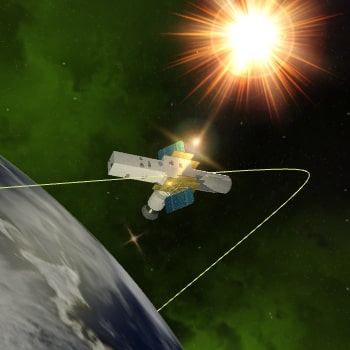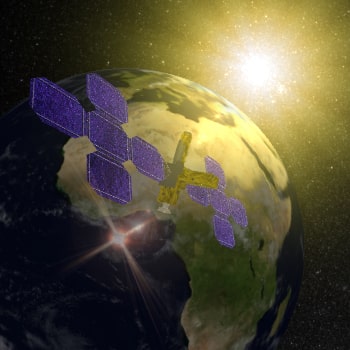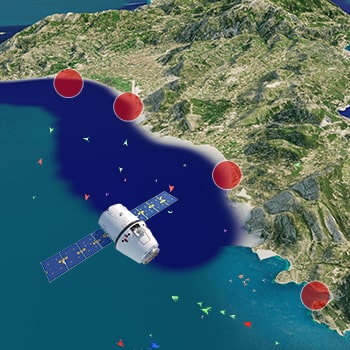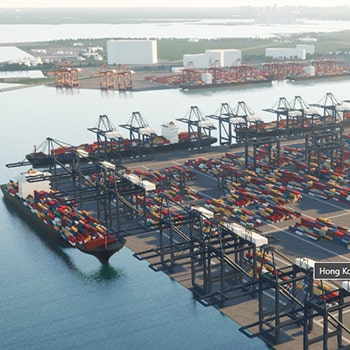Research
Research Experiences
- Astrodynamics
- Spacecraft trajectory optimization
- Application of artificial intelligence in space trajectory design and optimization
- Satellite dynamics and control
- Space rendezvous and satellite constellation
- Meta-heuristic and evolutionary computations
- Engineering application of machine learning techniques
- Satellite AIS data analysis
- Prediction of vessel arrival time
- Port congestion redution
Spacecraft Trajectory Optimization
The transfer trajectories for a space maneuver are critical when the travel time and the energy consumption of the spacecraft become the matter of importance in a space mission. In space
engineering, finding the optimal trajectory for transferring the space vehicle from one orbit to another is a challenging optimization problem. Due to nonlinearity of spacecraft dynamics and
the complexity of the mathematical model of the space environment, the optimal solution can not be achieved analytically. Therefore, numerical approaches are usually chosen for such problems.
With recent advances in artificial intelligence and high speed computation capabilities, evolutionary approaches are becoming more popular in tackling spacecraft trajectory optimization
problems. Novel meta-heuristics techniques, more specifically innovative evolutionary algorithms, have been applied to many trajectory optimization problems immensely. In this regard, the
development of new evolutionary algorithms for finding near-optimal transfer trajectories for spacecraft is a reputed field, in which both the aerospace engineering community and computer
science community can contribute with novel ideas.

Software Development for Space Orbit Simulation
Simulation platforms in space engineering are essential tools for space mission analysis and design. As the design and optimization rapidly grow in aerospace industries, the development of
simulation tools and packages becomes more important every year. Such simulation tools are used for real-world mission support, engineering studies, as a tool for education, and public
engagement. Since the vast majority of the key elements in simulating a space orbit are associated with design, optimization and 3D visualization, a practical software in this regard needs to
have significant features. These features include containing various orbit propagation models, supporting different space missions and flight regimes such as Earth orbiting missions, lunar
missions, libration points, deep space missions and interplanetary missions, having a user friendly environment and modularity.
Space Dynamics and Control
Spacecraft dynamics and control is the study of how spacecraft move and how their motion can be managed. It encompasses understanding the forces acting on a spacecraft, such as gravitational
forces from planets or moons, thrust from onboard propulsion systems, and disturbances like solar radiation. These dynamics govern everything from launching a spacecraft, navigating through
space, performing maneuvers, to safely landing or orbiting a celestial body. This field is crucial because it ensures that spacecraft reach their intended destinations and carry out their
missions accurately and safely. Without proper control, a spacecraft could veer off course, collide with other objects, or fail to achieve its mission objectives. It also plays a vital role
in adjusting a spacecraft's orientation, ensuring its instruments are properly aligned for communication, observation, or other tasks. In deep space exploration, satellite deployment, or
crewed missions, dynamics and control systems are essential for long-term mission success. They allow precise positioning for scientific data collection, optimal fuel usage, and the ability
to respond to unforeseen challenges in the harsh and dynamic environment of space.

Simulation and software development are critical components of spacecraft dynamics and control. In space, there's little room for error, and testing real spacecraft in actual conditions is
often impossible or prohibitively expensive. Simulation provides a safe and cost-effective environment to model and predict the behavior of spacecraft under various conditions, such as
different orbits, maneuvers, and unforeseen disturbances. In spacecraft dynamics, simulations are used to calculate trajectories, analyze forces acting on the spacecraft, and test responses
to control inputs. These models allow engineers to refine and validate their control algorithms long before the spacecraft is launched. Through simulation, they can study how the spacecraft
will behave in specific scenarios, identify potential issues, and optimize performance. Software development is equally vital because modern spacecraft rely on sophisticated onboard
computers to execute control commands in real-time.
These systems must be highly reliable and capable of handling complex calculations related to navigation, attitude control, and decision-making. The software manages tasks like adjusting the
spacecraft's orientation, activating thrusters, or controlling solar panels, and must work flawlessly in the harsh conditions of space. Both simulation and software development allow for
extensive testing and validation, reducing the risks of mission failure. They also enable adaptive control systems, which can respond autonomously to unexpected situations, ensuring mission
success in uncertain and dynamic space environments.
Satellite AIS Data Analysis
Today maritime transportation represents the majority of international trade volume and there are numerous vessels sailing the ocean every day. The challenges related to safety and security
aspects in the maritime domain are of high priority. Modeling ship behavior helps improve security for authorities and one crucial task of maritime surveillance is abnormal vessel behaviors
detection. Anomalies in the maritime domain, such as unexpected stops, deviations from regulated routes, inconsistent speed or direction etc., may be related to risks like collisions,
grounding, sea drunkenness, etc. To address the issue, different data sources such as data from Automatic Identification System (AIS) are used by the maritime authorities. In-depth analysis
of AIS data is critical in the maritime industry for several key reasons, primarily related to safety, efficiency, regulatory compliance, and operational optimization.
AIS data provides real-time information about a vessel's location, speed, course, and identity, which is invaluable for improving maritime safety. Detailed analysis allows authorities, vessel
operators, and ports to monitor traffic patterns, anticipate potential collisions, and improve navigational decision-making. By tracking vessel movements, risks of accidents or unsafe
encounters can be significantly reduced, ensuring smoother and safer operations at sea. From an operational perspective, AIS data analysis enables better fleet management and route
optimization. Shipping companies can analyze historical AIS data to identify trends and inefficiencies in voyage planning. This data helps optimize routes, taking into account factors such as
weather, currents, and port congestion, ultimately leading to reduced fuel consumption, shorter voyage times, and cost savings.

The regulatory environment also benefits from the insights gained through AIS data. Authorities can track vessel compliance with international maritime laws, such as emission control area
(ECA) regulations, and verify that ships are adhering to set traffic lanes and speed limits. Moreover, this data aids in identifying illegal activities, such as unauthorized fishing or
smuggling, making it an essential tool for maritime law enforcement. In addition, AIS data analysis is a key asset for improving port and terminal efficiency. By knowing the precise movements
of incoming vessels, ports can better coordinate docking, loading, and unloading operations, improving berth utilization and reducing wait times. In-depth AIS analysis also helps forecast
traffic trends, allowing for better long-term planning and infrastructure investment. Therefore, analyzing AIS data in-depth supports improved decision-making across various facets of the
maritime industry, including safety, operational efficiency, regulatory compliance, and resource management.
Estimation of the Time of Arrival
The estimation of the time of arrival (ETA) of vessels holds significant importance in the maritime industry due to its impact on operational efficiency, supply chain coordination, and cost
management. Ports depend on accurate ETAs to manage their resources effectively, ensuring that berths, cranes, and personnel are available when needed. A reliable ETA helps avoid congestion
at ports, minimizing delays and the associated costs. For shipping companies, it allows better fleet management by reducing idle time and enabling vessels to follow optimal routes. In the
broader supply chain, industries that rely on just-in-time logistics depend on accurate vessel arrival times to ensure that goods are delivered at precise intervals, minimizing warehousing
costs and avoiding disruptions in production. Cargo handling and logistics partners similarly rely on this information to plan the smooth loading and unloading of goods. From a cost
perspective, fuel consumption is closely tied to ETA. When vessels know their arrival times with precision, they can adjust speed accordingly, optimizing fuel use. Moreover, inaccurate ETAs
can lead to costly demurrage fees if ships are forced to wait for berth availability or miss contractual deadlines for cargo delivery. In summary, accurate ETA estimation is essential for
operational harmony, economic efficiency, and effective coordination across the maritime industry.
Bunkering Schedule Optimization

Optimizing bunkering schedules in maritime ports is critical for several reasons, particularly relating to cost efficiency, operational effectiveness, environmental compliance, and overall
supply chain coordination. Fuel is one of the most significant operating costs for vessels, and optimizing bunkering schedules helps reduce unnecessary fuel expenses. By planning bunkering
operations strategically, ship operators can take advantage of lower fuel prices at specific ports or during certain times, minimizing overall costs. Additionally, vessels that avoid
unnecessary idling or delays during bunkering can maintain fuel efficiency by staying on their optimal voyage schedules. From an operational perspective, poorly planned bunkering can lead
to congestion at bunkering stations or delays in port operations, disrupting vessel departure times and negatively impacting port efficiency. By carefully scheduling bunkering activities,
vessels can coordinate better with other port operations such as loading, unloading, and maintenance, avoiding delays that can cascade through the supply chain. Bunkering optimization also
supports compliance with environmental regulations. International maritime regulations, such as those set by the International Maritime Organization (IMO), often require vessels to switch
to cleaner fuels in emission control areas (ECAs). Optimizing the timing and location of bunkering allows vessels to meet these requirements efficiently, minimizing the need for last-minute
fuel changes or non-compliance penalties.
Additionally, optimizing bunkering schedules aids in the coordination of the broader supply chain. Shipping schedules are tightly interconnected with cargo handling, warehousing, and onward
transportation, and disruptions caused by inefficient bunkering can have a ripple effect. A well-planned bunkering schedule ensures vessels are ready to depart on time, maintaining the flow
of goods through the entire logistics chain. Optimizing bunkering schedules in maritime ports is essential for controlling costs, maintaining operational efficiency, ensuring environmental
compliance, and supporting smooth coordination across the maritime supply chain.
|
|
|
|
Copyright © 2014-2025 by Abolfazl Shirazi. All Rights Reserved.